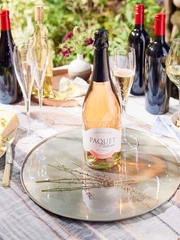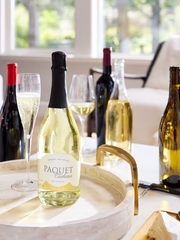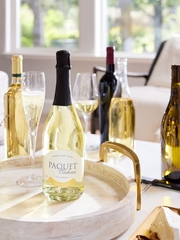 My dad switched careers after a family death and became a dealer of antique wood and furniture. He taught me what different oak varieties look like and that some were better for wine barrels and others to make furniture. He took me to his friend, a master barrel maker, to see how a barrel was made. The smell of weathered, toasted or shaved oak is incomparable and was anchored in my memory forever.
The background was now set, a chef, sommelier and a wood lover. How could I escape becoming a winemaker with that kind of family history?
My wine memories of childhood are often centered around our Sunday lunch ritual. My parents loved cooking. Once, I particularly remember tasting a glass of Chateau La Patache Medoc paired with a roasted, farm-fresh chicken: non-GMO, free-range, humanely raised, French style. Yes, this was all a thing back then.
My dad switched careers after a family death and became a dealer of antique wood and furniture. He taught me what different oak varieties look like and that some were better for wine barrels and others to make furniture. He took me to his friend, a master barrel maker, to see how a barrel was made. The smell of weathered, toasted or shaved oak is incomparable and was anchored in my memory forever.
The background was now set, a chef, sommelier and a wood lover. How could I escape becoming a winemaker with that kind of family history?
My wine memories of childhood are often centered around our Sunday lunch ritual. My parents loved cooking. Once, I particularly remember tasting a glass of Chateau La Patache Medoc paired with a roasted, farm-fresh chicken: non-GMO, free-range, humanely raised, French style. Yes, this was all a thing back then.
 For some reason, this wine resonated in my brain as the start of my wine life. How can you pack in a 750 ml glass such an amazing amount of flavors like strawberry, black currant, cigar box, cedar or toasted oak? I had to find out.
Enjoying wine paired with food has always been one of my true passions.
Besides getting me to taste wine early in my life, at around 12 years old, I was particularly interested in what my dad was doing in our kitchen. Before finishing a bottle of wine, he always left half a glass and poured it in a strange small barrel looking container. I learned later that this was the family recipe, “the motherload”. Indeed, my dad had traveled all his life with his grandfather's vinegar starter.
Homemade red wine vinegar has a much more complex, subtle flavor than most of the supermarket versions. Once you get a batch going, you can maintain it with just the occasional splash of wine leftover from the bottom of a bottle at the end of a party.
The "mother" of the vinegar is Mycoderma aceti, the beneficial bacteria that transforms alcohol into vinegar. The vinegar bacteria need oxygen to do their work, which is why you want the air space.
Over the next couple of weeks, a gelatinous disk will form on the surface of the vinegar. This is the visible form of the vinegar mother. This blob will eventually sink to the bottom of the vinegar and a new one will form on the surface. This looks creepy but is actually a sign that all is going well. They occur in apple cider as well as a host of other liquids, including wine. Most cider vinegars in grocery stores have been pasteurized.
For some reason, this wine resonated in my brain as the start of my wine life. How can you pack in a 750 ml glass such an amazing amount of flavors like strawberry, black currant, cigar box, cedar or toasted oak? I had to find out.
Enjoying wine paired with food has always been one of my true passions.
Besides getting me to taste wine early in my life, at around 12 years old, I was particularly interested in what my dad was doing in our kitchen. Before finishing a bottle of wine, he always left half a glass and poured it in a strange small barrel looking container. I learned later that this was the family recipe, “the motherload”. Indeed, my dad had traveled all his life with his grandfather's vinegar starter.
Homemade red wine vinegar has a much more complex, subtle flavor than most of the supermarket versions. Once you get a batch going, you can maintain it with just the occasional splash of wine leftover from the bottom of a bottle at the end of a party.
The "mother" of the vinegar is Mycoderma aceti, the beneficial bacteria that transforms alcohol into vinegar. The vinegar bacteria need oxygen to do their work, which is why you want the air space.
Over the next couple of weeks, a gelatinous disk will form on the surface of the vinegar. This is the visible form of the vinegar mother. This blob will eventually sink to the bottom of the vinegar and a new one will form on the surface. This looks creepy but is actually a sign that all is going well. They occur in apple cider as well as a host of other liquids, including wine. Most cider vinegars in grocery stores have been pasteurized.

 There is a little more than one gallon of the vinegar in the “Old Mother” barrel from my dad’s cellar. My dad's "mother" had been aging for decades, becoming darker and more intensely flavorful.
This is one of the childhood memories that I will cherish as long as I can and one that I can pass on to my kids. Thank you for your friendship, your protection, your passion and for providing me with the abilities to become who I am today.
Love you dad.
There is a little more than one gallon of the vinegar in the “Old Mother” barrel from my dad’s cellar. My dad's "mother" had been aging for decades, becoming darker and more intensely flavorful.
This is one of the childhood memories that I will cherish as long as I can and one that I can pass on to my kids. Thank you for your friendship, your protection, your passion and for providing me with the abilities to become who I am today.
Love you dad.
 Dominique Réblé, 1939-2019
Dominique Réblé, 1939-2019







